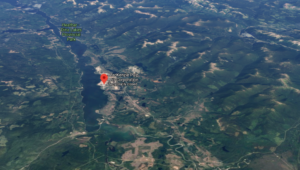Mackenzie, B.C.
April 7, 2024 By: Danielle Fernstrom
Location: 55.3381° N, 123.0945° W

Ecological History of Mackenzie, B.C.
The vast mountain ranges, plentiful rivers and abundant natural resources that surround my hometown of Mackenzie have shaped the ways humans have interacted with and altered the environment in the region. The mountain range that Mackenzie is nestled into is over 50 million years old, making the 55 years Mackenzie has existed look like a blink of an eye. However in this small amount of time human behaviour has had large impacts on the ecological state of the region. The Rocky Mountain Trench, in which Mackenzie sits, is a unique and bizarre geological formation that spans a considerable distance2. Its width ranges from three to six kilometres, its elevation above sea level is anywhere between 600 and 900 metres, and the whole thing stretches for about 1600 kilometres, from north of Mackenzie all the way to Montana. It’s no surprise, then, that this guiding geological feature has a First Nations history of travel and trade that goes back thousands of years2.
In fact it was through trade routes discovered and established with the first Nations that saw the first population boom in the area in recent history. The Northwest Company began trading furs and other resources with First Nations people and trappers during the early part of the 1800s (cite). By 1920 the Hudson’s Bay Company had moved into the region and established many successful trading posts. The ecological balance was disturbed by the introduction of new values and social patterns in the practice of long standing behaviours such as trapping. Over time, the European settlers have flooded the Omineca District in search of riches since the 1870s during the Cariboo Gold Rush2. This brought new behaviour to the environment that had not been historically experienced with the indigenous population that occupied the region up to this point. Communities were established that had the primary goal to extract what they could from the environment. The communities of the Germansen and Manson Creek area were established to accommodate these settlers in the area during this time. One of the largest ecological changes made over the history of the area’s development was during the construction of the W.AC. Bennett Dam signalled the end of many of the settlements along the Finlay and Parsnip rivers, as the Williston Lake Reservoir overflowed and flooded them. It was beside this new water-land boundary that in 1965 the land for Mackenzie to be built was cleared1. Mackenzie took on the resource extraction practices that the settlers in the gold rush established. Pulp mills and saw mills were built alongside Mackenzie to establish an economy from the natural resources around them. The extraction of lumber out of the region has been ongoing to this day. Over the course of this human-environment pattern of interaction there have been great shifts in the ecology of the region. The biodiversity of the forest has been drastically reduced with the practice of lumber management, water sources have been contaminated with perpetual dumping of unfiltered industrial effluent, and the balance of animal population is strained.
References
- “About Mackenzie.” District of Mackenzie, August 17, 2023. https://districtofmackenzie.ca/discover-mackenzie/about-mackenzie/.
- “History.” District of Mackenzie, November 12, 2020. https://districtofmackenzie.ca/discover-mackenzie/about-mackenzie/history/.